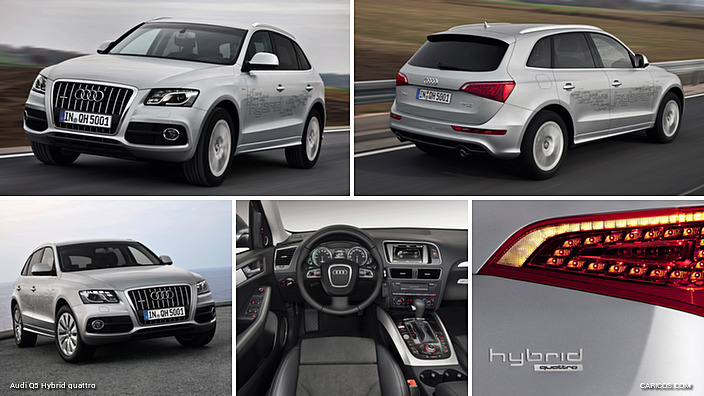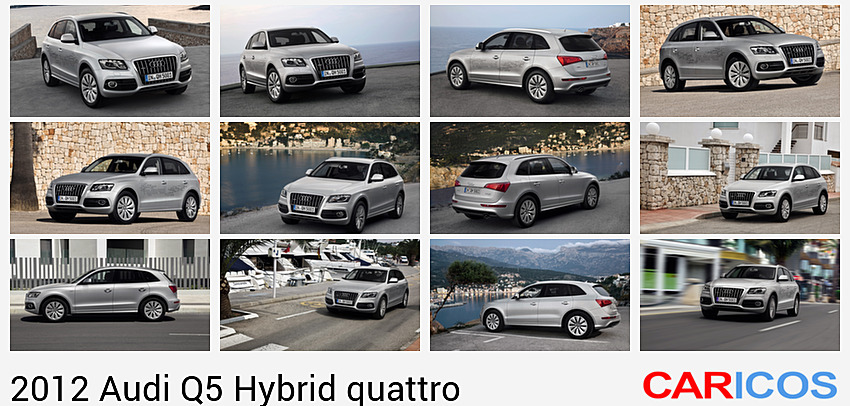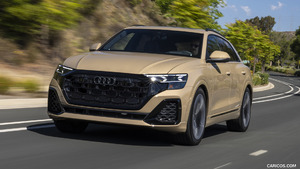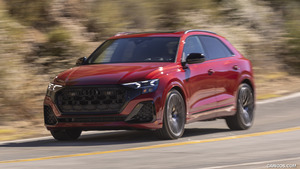2012 AUDI Q5 Hybrid Quattro
The Audi Q5 hybrid quattro combines the performance of a six-cylinder with the fuel economy of a four-cylinder. The highly variable interior offers plenty of room for recreation and family. The vehicle is powered by a 2.0 TFSI producing 155 kW (211 hp) and an electric motor producing 40 kW (54 hp). This combination provides for a system output of 180 kW (245 hp). The average fuel consumption measured according to the NEDC is just 6.9 liters per 100 km (34.09 US mpg). The quattro permanent all-wheel drive system and an agile chassis are an unbeatable technology package.
During the development process, Audi focused on a high share of electrically powered driving. The sportiest hybrid SUV on the market covers about three kilometers (1.86 miles) with zero local emissions at a constant speed of 60 km/h (37.28 mph), and can drive at up to 100 km/h (62.14 mph) under electric power alone.
The Audi Q5 hybrid quattro is the perfect car for an active lifestyle. It is efficient, dynamic, spacious, multifunctional and comfortable. It will be appearing in the fourth quarter of 2011 at a starting price of EUR 53,700.
Assistance systems: luxury from the full-size category
Upon request, Audi can equip the Q5 hybrid quattro with high-tech systems adopted from the full-size category, making driving an even more controlled, relaxing affair. The Audi parking system advanced employs a reversing camera to aid the driver in maneuvering; Audi lane assist helps the driver to maintain the lane; and Audi side assist alerts the driver to potential hazards during a lane change.
 2012 Audi Q5 Hybrid quattro
2012 Audi Q5 Hybrid quattro
The other equipment items likewise underscore the Audi Q5 hybrid quattro’s status as a performance model. These include the convenience key for keyless access, a large panoramic sunroof, three-zone automatic air conditioning, roller sun blinds for the rear side windows and the Audi adaptive light dynamic cornering light system. The high-beam assistant switches automatically between high-beam and low-beam headlights. The front seats can be adjusted, heated and cooled electrically.
- Body
- Length 4,629 millimeters (15.19 ft), width 1,898 millimeters (6.23 ft), height 1,625 millimeters (5.33 ft)
- Dynamic proportions, best-in-class drag coefficient of 0.32
- Two design packages available
- Cargo space
- Cargo capacity 460 to 1,480 liters (16.24 to 52.27 cubic ft)
- Numerous practical details for sports and recreational use, sliding rear bench seat (standard) and optional folding front passenger’s seat back
- Interior
- Long wheelbase of 2,812 millimeters (9.23 ft), generous amount of space, many storage facilities
- Intuitive controls, updated MMI system
- Particularly high standard of passive safety
- Engines and transmissions
- Hybrid drive system with a high system output of 180 kW (245 hp) through the combination of a 2.0 TFSI with 155 kW (211 hp) and an electric motor with 40 kW (54 hp). Maximum system torque is 480 Nm (354.03 lb ft)
- Low average fuel consumption of 6.9 liters per 100 km (34.09 US mpg); low CO2 emissions of 159 g/km (255.89 g/mile)
- 2.0 TFSI with direct fuel injection, turbocharging and AVS valve control system
- Chassis
- Front axle located further forward
- Hill descent assist standard
- Equipment
- Automatic air conditioning and Audi sound system standard
- Modern assistance and communications systems available
- Large panoramic glass roof available optionally
Engines and transmissions
The 2.0 TFSI in the Audi Q5 hybrid quattro has a displacement of 1984 cc. Its output is 155 kW (211 hp), with the maximum torque of 350 Nm (258.15 lb-ft) permanently available at 1,500 to 4,200 rpm. The 4-cylinder engine combines direct injection with turbocharging – typical for the Audi philosophy of downsizing, which replaces displacement by forced induction. The Audi valvelift system (AVS) further increases power, torque and efficiency by switching the stroke of the exhaust valves between two stages depending on the load and rpm.
The 2.0 TFSI has been overhauled in some respects for use in the Audi Q5 hybrid quattro. The drive of the ancillary units has been dropped, and the crankshaft bearing and fine tuning of the turbocharger have been adapted to the specific demands.
A secondary air system at the cylinder head makes sure that the exhaust gas treatment cuts in particularly fast. Integrated in the engine control unit, the hybrid manager controls the efficient change and smooth transitions between the operating modes, and was fully developed by Audi alone.
The optimal interplay between the combustion engine and the electric motor briefly results in a peak system output of 180 kW (245 hp) and a maximum system torque of 480 Nm (354.03 lb ft).
Drivetrain
A largely modified eight-speed tiptronic serves the power transmission without the aid of a torque converter. Its place is taken by the disk-shaped electric motor, combined with the multi-plate clutch operating in an oil bath – it couples and decouples the electric motor and the TFSI. The innovative decoupler operates with high precision, smoothly and quickly in any situation.
The highly comfortable and fast-shifting hybrid gear unit contributes significantly to the efficiency of the Audi Q5 hybrid quattro – its eight gears are widely spaced. When the 2.0 TFSI is turned off, an electric pump maintains the oil pressure in the hydraulic system to safeguard the convenient start-stop feature.
The power electronics and the electric motor
The power electronics, connected to the battery and the electric motor by high-voltage cabling, is located in the plenum chamber of the engine compartment. In the form of a pulse-controlled inverter, the power electronics serves as a controller between the battery, which outputs direct current, and the electric motor, which operates on alternating current.
Innovative technologies keep the volume and weight of the power electronics low, with cooling provided by a separate low-temperature water-filled circuit. The component includes a DC/DC converter that couples the electric consumers in the 12 V electrical system with the high-voltage network.
A permanent magnet synchronous machine serves as an electric motor, as a starter and – during deceleration – as a generator. It delivers up to 40 kW (54 hp) of power and 210 Nm (154.89 lb ft) of torque. The electric motor is integrated in the engine’s cooling circuit.
The battery
A lithium-ion battery system, weighing a mere 36.7 kg (80.91 lb), serves as the energy store for the electric motor of the Audi Q5 hybrid quattro. The compact unit with its 26 liter (6.87 US gallon) capacity is positioned in a crash-safe area under the cargo floor, with hardly any intrusion on the cargo area. The battery consists of 72 cells. At 266 volts, its nominal energy is 1.3 kWh and its output 39 kW.
The lithium-ion battery is cooled by air in two ways, depending on the requirement. At low-temperature load, it draws temperate air from the vehicle interior by way of a fan. If its temperature exceeds a certain limit, a separate refrigerant circuit is activated. It is coupled to the main climate control system of the vehicle and uses a separate evaporator
This heavy-duty active cooling system distinguishes the Audi Q5 hybrid quattro from many other hybrid vehicles, and makes a key contribution to the high electrical availability of the hybrid system.
Multimedia systems
The area of multimedia, in which online services, information, entertainment, navigation and telephony all come together, is one of the most attractive fields of contemporary and future technology. Here, too, the Audi Q5 hybrid quattro sets new standards within its segment – it makes its debut with an extremely wide range of technologies.
The superior solution: the MMI operating system
The Audi Q5 hybrid quattro comes standard with the driver information system and MMI navigation plus with its large seven-inch monitor. Both systems use elegant, seemingly three-dimensional graphics to display the operating states and power flows in the hybrid system. The MMI monitor also displays differentiated consumption and recuperation statistics in easily understandable bar graphs.
The Audi Q5 hybrid quattro comes with the latest-generation MMI navigation plus. It has a 20 GB hard drive for media files, the menus can be selected via a state-of-the-art wizard, and the album tracks are displayed using the cover artwork. An external device such as a cell phone or MP3 player can be connected via Bluetooth, and the voice input understands town and street names in a single command. The resonant Audi sound system is also standard.
The optional Bluetooth online car phone makes it possible to connect to the Internet. A UMTS model sets up the connection to special services from Google and the World Wide Web, bringing the latest news and weather information into the vehicle.
The driver can plan his or her travel route at home, save the information in an area of the internet site www.audi.com and from there download the data into the navigation system via UMTS at the start of the trip. Through the fast connection the hybrid SUV also downloads three-dimensional satellite images and aerial photos from Google Earth. These appear as bird’s eye views on the monitor; the computer draws in the roads.
Another high-end feature is the WLAN hotspot, which allows up to eight terminal devices to connect to the Internet. Communication occurs via the roof antenna, the connection is very stable and the reception quality excellent. Thanks to a special modulation process, UMTS data transfer occurs at speeds up to 7.2 MB per second. Encryption follows the WPA 2 standard – a very secure method.
The use of the WLAN hotspot is as easy as can be – the driver need merely insert a data-capable SIM card. At the same time the driver can pair a cell phone with the system via Bluetooth, if the phone has the SIM Access Profile. The existing mobile phone contract with a data option suffices in most cases with the result that no additional charges or separate contracts are necessary.











